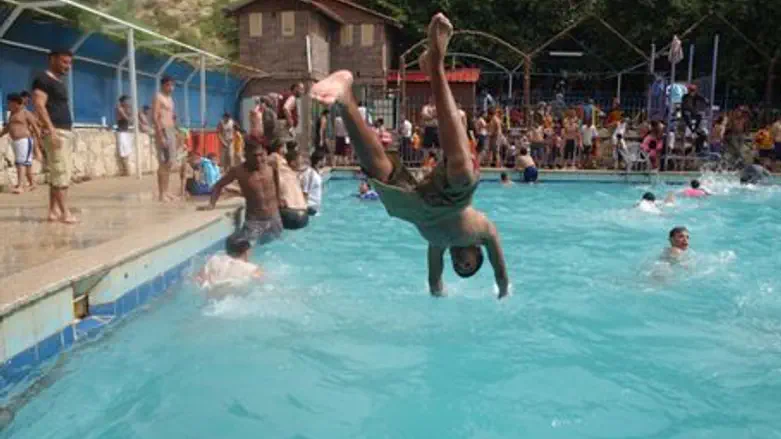
A National Geographic exhibit on water that ended June 13 has caused anger due to its obvious anti-Israel bias. The photography exhibit entitled "Water: Our Thirsty World" was criticized by Israeli Consul Yaakov Dayan and the Jewish Community Relations Council of Washington.
Photographs by Paolo Pellegrin show Arabs dealing with scarce water supplies, while Israelis are pictured enjoying themselves on the banks of the Kinneret (Sea of Galilee) and at a water park. None of the swimming pools or fresh-water beaches located in the Palestinian Authority-controlled regions of Judea and Samaria or in Gaza are pictured.
Where are the pictures highlighting Israel's extraordinary efforts to conserve and recycle water, its global leadership in cutting-edge desalination or water-saving technology, or its collaborative efforts with neighbors including Jordan and the Palestinian Authority to cooperate in water sharing ventures?The caption of one photo reads: “A source of conflict between Israelis and Palestinians, water is emblematic of their unequal relationship. During dry summers, West Bank Palestinians—restricted to shallow wells by Israel’s occupation—have to buy groundwater tapped from beneath them.” In actual truth, Israeli water experts say that the PA Arabs are destroying the aquifer that is the source of water for both areas.
A second caption claims that Israelis “bask in [water's] relative abundance,” and cites a World Bank report saying Israelis use four times as much water per capita as PA Arabs. An Israeli denial of the report is also mentioned.
Yet another caption states, “Since 1967, Israel has blocked Syria's access to the shoreline” of the Kinneret. As Syria no longer shares a border with the Kinneret, and bombarded Israeli communities from the heights above it until it attacked Israel and lost the Six Day War, the charge of "blocked access" is not clear.
"In a blatant misrepresentation of the truth, the photos and captions suggest that the Israelis frivolously consume water while denying it to, even stealing it from, their neighbors,” said JCRC director Ron Halber.
"Where are the pictures with captions highlighting Israel's extraordinary efforts to conserve and recycle water, its global leadership in cutting-edge desalination or water-saving drip-irrigation technology, or its collaborative efforts with neighbors including Jordan and the Palestinian Authority to cooperate in water sharing ventures, even in times of political conflict?" Halber asked.
Dayan voiced similar thoughts, saying the exhibit “manufactures an outrageous fiction wherein Israel is depicted as stealing and hoarding water while her neighbors suffer from drought.”
“This is not only false, but the exact opposite is true,” he added.
National Geographic staff said in response that the photographs were taken from an article that did refer to cooperation between Israel and neighboring Arab countries regarding water.
National Geographic has been accused of anti-Israel bias on several occasions. Articles published in the 1990s led to accusations that the magazine supported revisionist history, depicting PA Arabs as descendants of the biblical Canaanite nation while ignoring Jewish history in Israel in recent centuries.
One article written during the Oslo Accords referred to Fatah head Yasser Arafat as a “peacemaker,” while Israel's government of the time was referred to as “hard-line.” A 2002 report that purported to give a history of the Israeli-Arab conflict did not mention Arab leaders' refusal to negotiate or the Yom Kippur War, and wrongly claimed that Jews had been treated well under Ottoman rule.
A more recent article, printed in the June 2009 issue, implicated Israel in the decreasing PA Christian population. The article did not note that Israel's Christian population enjoys a high growth rate, and ignored Muslim oppression of Christians under the PA which is the main reason for the population decline.